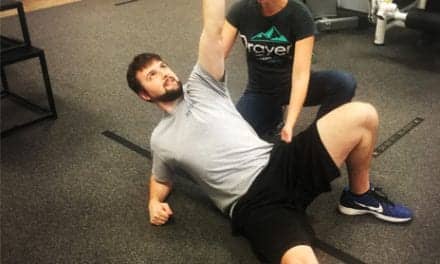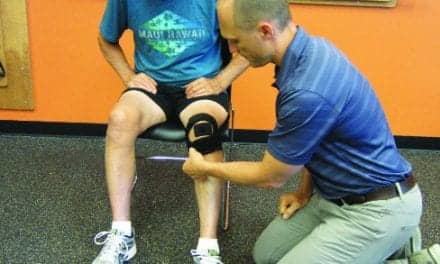By Jeffrey Larson, PT, ATC
Hot and cold therapy equipment has come a long way from the Greek baths and the more recent hot water bottles and ice packs. New technology has changed the use of hot and cold therapy, creating new treatment options for clinicians and their patients. Since the introduction of the hydrocollator hot pack in the late 1940s, physicians and therapists have continued to use this classic modality as an adjunct to their treatment plan.
Considered economical and easy to use, HotPaC from Chattanooga, a DJO Global company, Vista, Calif, is just one example of the hot packs used with a hydrocollator in physical therapy departments and training rooms. Once removed from the water-filled hydrocollator heating unit, the pack is wrapped in a terry cover and numerous layers of towels for safety prior to applying to the treatment area. Providing up to 30 minutes of deep, soothing, moist heat, the therapeutic benefits can be used as an adjunct either prior to or during stretching.
Moist heat from hot packs is found to decrease muscle spasms and improve relaxation, resulting in less stiffness and increased mobility needed for the continuation of a therapeutic exercise session. Battle Creek Equipment Co, Fremont, Ind, is an additional source for moist heat therapy packs. Its Thermophore Professional pack features a three-temp time switch, wipeable heating unit, and removable drape pack that can be used separately once heated.
The application of cold packs (ie, cryotherapy) provides analgesic effects particularly useful during acute phases of treatment. Cold packs such as the ColdPaC, also from Chattanooga, can be used independently or also as an adjunctive modality.
Additionally, manufacturer Southwest Technologies Inc, North Kansas City, Mo, markets a line of reusable packs designed in a range of shapes and sizes that feature Elasto-Gel and provide duality for hot and cold therapy; offering the ability to heat or freeze.
A very useful and common form of cryotherapy is compression combined with cold therapy, which provides not only the effects of cold therapy but also compression to help reduce swelling and control inflammation. One particular method is applying a cold pack with a vasopneumatic compression device.
Such compression devices are used for edema reduction and are also useful for this method of cryotherapy. One particular unit by KCI called the Jobst System 7000 Intermittent Compression Pump works well for this application as it provides intermittent, single-chambered uniform compression to manage and reduce peripheral swelling and edema. The compression is accompanied with an adjustable pressure range of 1-100mmHg and a cycle time of 90 seconds inflation and 30 seconds deflation. Other types of devices on the market that aim to reduce swelling and minimize pain by integrating compression and cold therapy include the Game Ready control unit by Game Ready, Concord, Calif, and the HyperIce Ice Compression Device, a portable ice compression device that can be used for athletes and rehabilitation patients available through MeyerPT, Hudson, Ohio.
Depending on the desired effect, electrical stimulation can be used with either cold or hot therapy. One example for the reduction of inflammation and pain is utilizing an interferential current (IFC) with a cold pack. Salt Lake City-based Dynatronics’ Solaris has the capability to deliver IFC and provides a sweep or target option. By the clinician gliding the finger across a target touch pad, the center of interference is moved precisely to the site of the patient’s pain.
Another example to reduce inflammation and pain utilizing cold therapy is using a cold pack in combination with electrical stimulation and vasopneumatic compression and IFC. Now the patient benefits from the cryotherapy as well as IFC and vasopneumatic compression in one treatment session.
Manual Therapy in Conjunction with Hot and Cold Therapy
Soft-Tissue Mobilization
Whether it is gentle effleurage or the muscle-kneading manipulation of petrissage, moist heat from a hot pack prior to the treatment dilates the blood vessels, allowing improved circulation. This promotes relaxation of the muscles and tendons, allowing the soft-tissue mobilization to be more effective and efficient. The results of more advanced techniques like deep friction and trigger point/soft-tissue release can benefit from heat, helping to lessen scar tissue, absorb swelling, and decrease muscle spasm—all of which are important when muscle fascia elongation is desired. Clinicians may finish a session with an ice pack, as some of the soft-tissue techniques such as deep friction massage and aggressive scar mobilization can become uncomfortable and initiate a mild, temporary inflammatory response.
Joint Mobilization
Moist heat prior to joint-mobilization techniques can produce an environment enhancing a joint’s natural arthrokinematics, including gliding, distraction, or pivoting. Because heat can increase relaxation of muscles around the targeted joint and promote articular elasticity, mobilization techniques are more effective, efficient, and likely tolerated better by the patient. This can be a key component to restoring normal joint mobility early in the treatment program and ultimately lead to a quicker return to normal motion. Whichever the manual therapy technique used, hot therapy can promote general relaxation of the “nervous” patient, lessening anxiety and nervousness prior to any technique. Similar to soft-tissue mobilization, cold therapy may be useful if the joint becomes uncomfortable, resulting in a mild temporary inflammatory response.
Hot and Cold for Home
Hot and cold therapies can be very effective, adding to the patient’s home program and for sports enthusiasts and weekend warriors. Now commonly used are the versatile packs that can be warmed in the microwave or cooled in the freezer. Soft Comfort CorPaks by Core Products, Osceola, Wis, are designed to be a soft and frost-free pack not needing to be wrapped in a towel. They are reusable, long-lasting, and come in various sizes and shapes to match the targeted body region. Additional sources for hot and cold packs include the Tucker, Ga-based company American 3B Scientific, which offers a variety of cold packs and moist heat hot packs that can be boiled or warmed in the microwave with terry cloth.
[sidebar float=”right” width=”250″]Product Resources
The following companies also provide topicals and key products for hot/cold therapy:
ActivaTek/North Coast Medical
www.activatekinc.com
ActiveWrap
www.activewrap.com
Ari-Med Pharmaceuticals
www.ari-med.com
Battle Creek Equipment Co
www.battlecreekequipment.com
Biofreeze/Performance Health
www.biofreeze.com
Chattanooga, a DJO Company
www.djoglobal.com/our-brands/chattanooga
Dynatronics
www.dynatronics.com
Empi, a DJO Global company
www.djoglobal.com/our-brands/empi
OPTP
www.optp.com
Pro-Tec Athletics
www.pro-tecathletics.com
Richmar
www.richmarweb.com
Roscoe Medical
www.roscoemedical.com
Sombra Professional Therapy Products
www.sombrausa.com
Sore No More
www.sorenomore.com
Southwest Technologies Inc
www.elastogel.com
Topical BioMedics
www.topicalbiomedics.com[/sidebar]
Topical Analgesics
Adding to the clinician’s arsenal for treatment of soft-tissue pain and joint-related conditions are topical analgesics. These products have active ingredients such as menthol; are manufactured in the form of sprays, creams, or gels; and are easy to apply. Menthols act as a pain-relieving mechanism caused by inhibiting pain signals traveling to the brain. As a result, a local analgesia effect occurs at the site of the application, providing pain relief to the patient. Akron, Ohio-based company The Hygenic Corporation’s Biofreeze is just one example of a topical analgesic that delivers the therapeutic benefits of cryotherapy. The mechanism of menthol continues to be investigated with one study comparing the treatment of back pain using a menthol product such as Biofreeze to the TENS system. The study shows the topical analgesic Biofreeze and the TENS system produced the same amount of pain relief for the treatment of back pain.1
Sore No More, headquartered in Moab, Utah, also features menthol as an active ingredient in its topical analgesic Sore No More, which is made to offer all-natural pain relief. Sombra Professional Therapy Products, Albuquerque, NM, also provides pain-relieving gels engineered with warming and cooling ingredients. Another option in this category is Flexall pain-relieving gel from Tempe, Ariz-based Ari-Med Pharmaceuticals, offered in two strengths.
Iontophoresis
Iontophoresis primarily is used to control and reduce inflammation. Most units consist of a compact phoresor that operates with a 9-volt battery and two wire leads each connected to an electrode. One electrode is the drug-delivery electrode, and the other is used as a dispersive electrode with the opposite charge of the anti-inflammatory ion. Corticosteroids are the principal drugs used with iontophoresis in rehabilitation because they have an anti-inflammatory effect and are relatively inexpensive. Providers of iontophoresis products and equipment include ActivaTek Inc, Gilroy, Calif, which offers iontophoretic devices, including the ActivaDose II, as well as Richmar, Chattanooga, Tenn, which also markets laser and electro-therapy equipment.
Advances in phoresor technology provide additional options to the clinician when using this topical modality. IOMED’s PM850 phoresor allows the clinician to deliver a specific dose from 0 to 80 mA-minutes and to control the current from 0 to 4 mA. This phoresor along with several other units will automatically calculate the required time for the selected dose, even if the current setting is changed during treatment. PTP
Jeffrey Larson PT, ATC, is director of physical therapy at the Tioga Medical Center in Tioga, ND. He is a graduate of North Dakota State University and the University of Utah, and holds degrees in both athletic training and physical therapy. Larson is also a medical writer and founder of Northern Medical Informatics, a medical communications business focused on continuing education for the allied healthcare professions and consumer health education. He is a member of the American Physical Therapy Association and the American Medical Writers Association. For more information, contact [email protected].
References
- Garra G, Singer AJ, Leno R, et al. Heat or cold packs for neck and back strain: a randomized controlled trial of efficacy. Acad Emerg Med. 2010;17:484-489.
- Bishop B, Greenstein J, Topp R. Effects of biofreeze versus ice on acute, non-complicated neck pain. (Abstract). Clinical Chiropractic. 2011;14(4):153-54.









